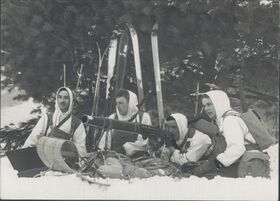Operation Antiochus
This article is incomplete because it is pending further input from participants, or it is a work-in-progress by one author. Please comment on this article's talk page to share your input, comments and questions. Note: To contribute to this article, you may need to seek help from the author(s) of this page. |
| Operation Antiochus | |||||||
|---|---|---|---|---|---|---|---|
| Part of the Scandinavia Campaign of the Seleucid Uprising | |||||||
 An ERUAC Machine Gun Team in the outskirts of Heimdallr | |||||||
| |||||||
| Belligerents | |||||||
|
Allied Security Forces
Other Allied Nations: | |||||||
| Commanders and leaders | |||||||
| |||||||
| Strength | |||||||
|
2.1 million personnel 3,150 tanks 2,750 AFVs 5,500 guns 3,980 aircraft |
3 million personnel 4,750 tanks 3,980 AFVs 7,200 guns 4,750 aircraft | ||||||
| Casualties and losses | |||||||
|
By December 1951:
|
By December 1951:
| ||||||
Operation Antiochus (21 June 1951 - 21 December 1951) was the code name for the Deseleni invasion of the Erebonian Empire by the Impeial Deseleni Empire and its satellite states, which started in 21 June 1951, during the Selucid Uprising. The operation was named after Emperor Antiochus IV Epiphanes, a Selucid Emperor and Ruler from antiquity. The operation put into action the Deseleni's ideological goal of conquering the Scandinavian regions to repopulate it with pure Selucid peoples. The Deseleni Generalplan Ost aimed to use some of the conquered people as slave labour for the Deseleni war effort while acquiring the oil reserves and mining regions of Northern Erebonia, the control of the Arctic Ocean, the use of Erebonia as a springboard for an invasion of the Lucis Isles, and the control of agricultural resources of various Erebonian territories. Their ultimate goal included the eventual extermination, enslavement, Deselenisation, and mass deportation to Southern East Europa of Non-Deseleni peoples, and to create more living space for the Deseleni Empire.
Although consideration was given due to the history of past military forces attempting to invade Erebonia, the Deseleni High Command was confident that Erebonia will fall by Autumn or before 1951 ends. Over the course of the operation, over 3 million personnel of the Deseleni forces-the largest invasion force in the history of Eordis-invaded the Southern Erebonian Empire along a 2,100-kilometer front, with over 600,000 vehicles for non-combat operations. The offensive marked the peak of the Selucid Uprising, both geographically and militarily with both sides pitting their best units. The area saw some of Eordis' largest battles and most horrific atrocities which influenced the outcome of the battle. The Deselenis were able to capture some 1 million civilians, soldiers, and other foreigners, which in turn were forced to work to the brink of starvation. Mass shootings were carried out as plan of the Deselenisation of Erebonia.
Although Erebonia's mountainous terrain favoured the defenders, Allied planners were worried about the Deseleni Empire's powerful military overwhelming the realms of the Empire. As a result, the task to defend Erebonia fell to Field Marshal Archibald Sugiyama and Quenminese Marshal Kiều Hữu Dương, both of which were masters of defensive strategies. Sugiyama planned out small-scale offensives meant to delay the Deseleni forces from being able to achieve their objectives in time for the harsh Erebonian Winter, hence Sugiyama often gave ground to allow Duong's strategy to unfold and entrap Deseleni forces. On the other hand, Erebonian resistance to Deseleni invaders were strong, as a result, several partisan groups banded together and cooperated with the Imperial Army of Erebonia in order to delay or stall Imperial movements. The Erebonian Government also carried out a scorched-earth policy to deny the invaders of resources.
The failure of Operation Antiochus reversed the fortunes of the Deseleni Empire for the rest of the war. Operationally, Deseleni forces achieved victories and occupied a handful of important territories and inflicted casualties on the Allies. Despite these early successes, the Deseleni offensive stalled in Operation Nicator just outside of Heimdallr, Trista, and Leeves at the end of 1951, and the subsequent Allied counteroffensive pushed the Deselenis about 300 km back. The Deselenis had confidently expected a quick collapse of Allied resistance as with much of their conquests in Lorica and in the Middle East, but the Allied forces absorbed the Deseleni Imperial Army's strongest blows and bogged it down in a war of attrition for which the Deselenis were unprepared. The Deseleni's diminished forces could no longer attack along the entire Scandinavian Front, and subsequent operations to retake the initiative such as Fall Dunkelblau and in Case Eumenes eventually failed, which resulted in the Deseleni's retreat and collapse.